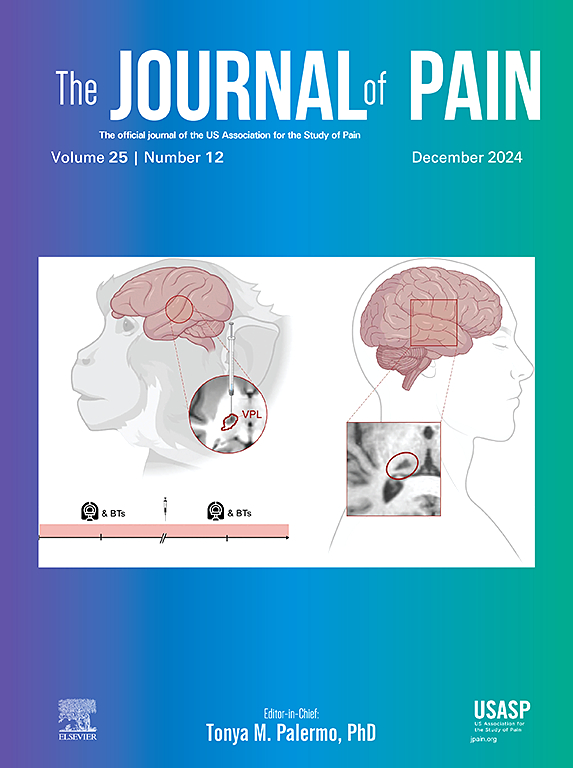Comparable Conditioned Pain Modulation and Painful-Exercise-Induced Hypoalgesia in Healthy Young Adults: A Randomized Crossover Trial
IF 4
2区 医学
Q1 CLINICAL NEUROLOGY
引用次数: 0
Abstract
Conditioned pain modulation and exercise-induced hypoalgesia reflect inhibitory pain controls emanating from the brain. The aim of this study was to compare the extent of pain inhibition from exercise-induced hypoalgesia (isometric wall squat), conditioned pain modulation (cold-water immersion), and their combination (wall squat followed by cold water in fixed order) in healthy pain-free adults. Sixty-one participants (median age 21 years) completed 3 sessions (wall-squat, cold-water, and combined) in random order. Sessions were separated by at least a week. In each session, pressure-pain thresholds, single-pinprick-pain ratings, and pinprick-temporal summation of pain (the fifth minus the first) were obtained at quadriceps, forearms, and forehead, before and after wall squat and/or cold water. Each intervention inhibited pain to pressure (partial η2 = .26) and single pinprick (partial η2 = .16) to a similar extent; however, pressure-pain inhibition was negligible in the forehead. After adjusting for age and sex, single-pinprick-pain inhibition in the forehead induced by wall squat was associated with that induced by cold water (adjusted R2 = .15; P = .007), and stronger pain inhibition was predicted by a higher thigh-pain rating to wall squat (adjusted R2 = .10; P = .027). Neither intervention affected pinprick-temporal summation of pain. Together, the findings suggest that pain-inhibitory effects of exercise-induced hypoalgesia and conditioned pain modulation may overlap when exercise is at least moderately painful (6/10 intensity). Pressure pain in body regions remote from the exercised or conditioned sites may be weakly modulated.
Perspective
The current findings suggest that pain-inhibitory effects induced by painful wall squat and by cold-water immersion may overlap. The magnitude of pain inhibition in the forehead remote from the exercised thigh or the conditioned foot appears smaller, which could be examined further in future research.
健康年轻人的条件性疼痛调节和疼痛运动诱发的低痛感具有可比性:随机交叉试验
条件性疼痛调节和运动诱发的低痛感反映了来自大脑的抑制性疼痛控制。本研究旨在比较运动诱导的低痛感(等长壁蹲)、条件性疼痛调节(冷水浸泡)以及它们在健康无痛成年人中的组合(先壁蹲后冷水浸泡,顺序固定)对疼痛的抑制程度。61 名参与者(中位数年龄为 21 岁)以随机顺序完成了三次训练(壁蹲、冷水浸泡、组合训练)。每次训练至少间隔一周。在每个疗程中,在深蹲和/或冷水浴前后,分别在股四头肌、前臂和前额采集压力-疼痛阈值、单次针刺疼痛评级和针刺-疼痛时程总和(第五次减去第一次)。每种干预措施对压力痛(部分η2 =.26)和单次针刺痛(部分η2 =.16)的抑制程度相似;但对前额压力痛的抑制作用微乎其微。在对年龄和性别进行调整后,墙蹲引起的前额单次针刺疼痛抑制与冷水引起的单次针刺疼痛抑制相关(调整后的 R2 =.15;p =.007),大腿对墙蹲的疼痛评分越高,疼痛抑制越强(调整后的 R2 =.10;p =.027)。两种干预措施都不会影响针刺-时间疼痛总和。总之,这些研究结果表明,当运动至少有中等程度的疼痛(6/10 强度)时,运动引起的低痛和条件性疼痛调节的疼痛抑制作用可能会重叠。远离运动部位或条件部位的身体区域的压痛可能受到微弱的调节。综述:目前的研究结果表明,疼痛性壁蹲和冷水浸泡引起的疼痛抑制作用可能会重叠。远离运动大腿或条件足的前额的疼痛抑制幅度似乎较小,这可以在今后的研究中进一步探讨。
本文章由计算机程序翻译,如有差异,请以英文原文为准。
求助全文
约1分钟内获得全文
求助全文
来源期刊

Journal of Pain
医学-临床神经学
CiteScore
6.30
自引率
7.50%
发文量
441
审稿时长
42 days
期刊介绍:
The Journal of Pain publishes original articles related to all aspects of pain, including clinical and basic research, patient care, education, and health policy. Articles selected for publication in the Journal are most commonly reports of original clinical research or reports of original basic research. In addition, invited critical reviews, including meta analyses of drugs for pain management, invited commentaries on reviews, and exceptional case studies are published in the Journal. The mission of the Journal is to improve the care of patients in pain by providing a forum for clinical researchers, basic scientists, clinicians, and other health professionals to publish original research.
 求助内容:
求助内容: 应助结果提醒方式:
应助结果提醒方式:


